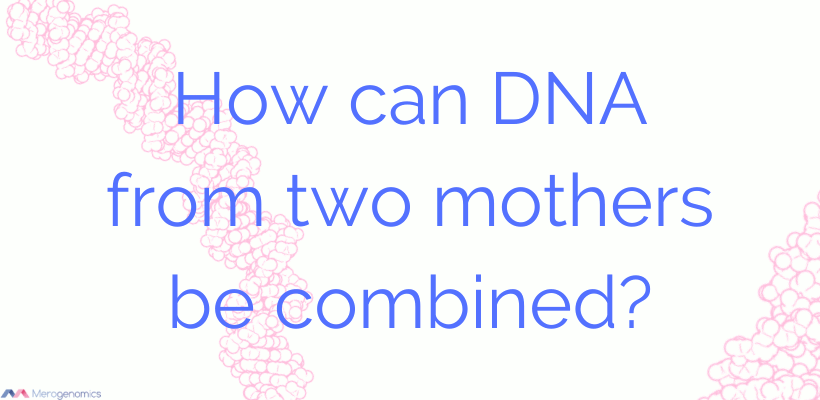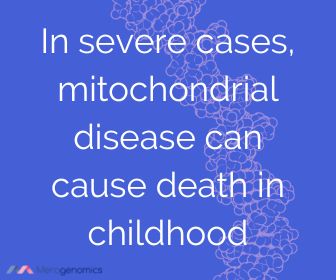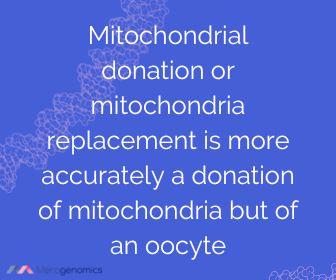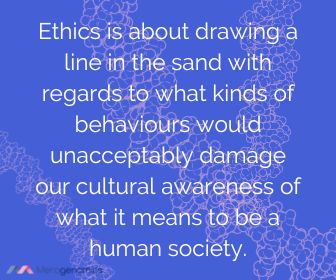
Mitochondrial donation - rescuing maternal-only DNA
Dr.M.Raszek and Dr.R.Della-Bosca
Part I: Technology and Regulation
Mitochondrial uniqueness
Mitochondria are curious components of cells because they come with their own genetic material. Trying to compare how much human DNA is in mitochondria versus in the cell nucleus is like comparing the size of the sun and earth. While the difference is enormous in favour of the nucleus, together, the mitochondrial DNA and nuclear DNA comprise the genetic material of the heritable human genome.
Mitochondria are not just special for being the only organelle with their own DNA (organelles are like organs of the cell, hence the name). Mitochondrial DNA is only passed on from mothers. As this specific DNA is only passed on by women, the inheritance of that DNA tracks genetic history contributed from that single biological sex. It is similar to how males have a Y chromosome inherited from father to son, but mitochondria are passed on by mothers to all their offspring. Thus, inheritance of mitochondria is never interrupted between generations. Mothers leave their own genetic footprint on all human beings in the world. Technically, mapping mitochondrial DNA allows deciphering how women of the world are related to one another, and how women of our species have evolved over time.
Like power-plants that convert some kind of natural fuel into electricity that we all use, mitochondria take sugar and convert it into something like a form of electricity in our cells, storing it in a chemical that is transported around. This chemical is referred to as ATP (adenosine triphosphate). Just like we can take batteries and recreate “electricity” where we feel we need it, the cell can use its own “battery” in the form of ATP. That “battery” chemical that mitochondria produce, ATP, fuels everything in our bodies. It is our power source that runs everything. Therefore, if you think of the nucleus of the cell where all of the other DNA resides as the brains of the cell, then the mitochondria are like the lungs of the cell where every breath exhales by-products and takes in fresh fuel for the body (also a chemical, the oxygen). If our lungs stop working, we die. If mitochondria stop working, the cell dies. Mitochondria keeping cells alive is a super important function — and it comes with its own genetic instructions!
Mitochondrial function is governed by the instruction code in its own DNA — if you are curious, mitochondrial DNA has 13 genes involved in energy production out of 37 in total — as well as by the nucleus itself. While mitochondria are not autonomous in their own rule deciding their fate, definitely their own DNA gives them a voice in deciding how they are to be run. These are very important and powerful instructions.
The genetic code can always be mutated, and indeed it constantly mutates. While mutations are changes to the genetic code that could provide an advantage or disadvantage, as mitochondria are power houses with many important pieces necessary for cellular life, mutations of their genetic code can be very serious. As mitochondria have many engines to create the ATP batteries needed in an entire body and any one of them of these engines could be affected, mitochondrial mutations can create a wide range of diseases. Some are devastating. It depends on how profoundly the function of mitochondria is affected by mutations. In severe cases, mitochondrial disease can cause death in childhood. Worse still, there are no known cures for mitochondrial diseases. In severe cases, mitochondrial
Options for women
For women who wish to have biological children but who are at high risk of imputing serious mitochondrial disease to their offspring, there are few options. None are without medical risks or moral challenges. The options are:
- Pre-implantation genetic diagnosis The intended mother’s oocyte is fertilized with in vitro fertilization and allowed to grow into a multicellular mass (blastocyst) that is tested for mitochondrial disease. If it is identified, the ensuing zygote blastocyst is not used for implantation. This procedure reduces but does not eliminate the risk of a baby developing mitochondrial disease, and does not eliminate the risk of mitochondrial disease developing in the subsequent generation.
- Invasive prenatal genetic testing and termination of high-risk embryo/fetus Either natural conception or in vitro fertilization may be used but identification, at 11-14 weeks gestation, of the baby’s risk of mitochondrial disease informs the parents’ decision-making about continuity of the pregnancy.
- Using healthy donated mitochondria The nucleus of the intended mother’s egg is combined with healthy mitochondrial material from a second woman, as described below.
Mitochondrial donation (or how to have three genetic parents)
It is now an option for women who have mitochondria with affected function to consider having a biological child using healthy mitochondria obtained from a donor. This reproductive technology is referred to as mitochondrial donation or mitochondria replacement; although more accurately, it is not just a donation of mitochondria but of an oocyte (the egg that is to be fertilized). All of the contents of the oocyte are donated, and the mitochondria with proper function hitch a ride inside. The donor’s oocyte nucleus is removed and substituted with the nucleus from an oocyte of the intended mother whose mitochondria are not working so well. It is done this way because it is currently not feasible to successfully isolate mitochondria. There are too many mitochondria strewn about the cell and not all are identical (this is referred to as heteroplasmy). Isolation of the intended mother’s egg nucleus is much easier.
In short, mitochondrial donation is more technically an oocyte donation with a nucleus exchange. This has its own enormous significance. That is because it is the oocyte that introduces all of the molecular machinery necessary to produce future life in the form of a new baby. The molecular machinery is made up of chemicals and proteins that act in concerted unison to execute the grand design encoded in the genetic material. While the nucleus provides the instructions on how the new life is to be created, all the ingredients for actually creating that new life are dependent on the oocyte and what it comes with. The proteins in the oocyte are the molecular robots that execute the bulk of this action.
Every oocyte comes with its own unique design. No two oocytes can be identical in how they are produced and what content they have. It’s just like no two snowflakes are identical due to the randomness effect. It is that unique donor’s oocyte that actually does the work of creating the new baby. Thus, it is the donor’s cell that is ultimately responsible for creating the new baby, even though it no longer retains the nuclear background of the donor.
What is somewhat abstract is that three people are involved in producing a future human being. That human being will retain the genetic inheritance of these three parents and be able to pass it on to the next generation. The first genetic parent is the contributor of sperm DNA. The second genetic parent, the intended mother, provides nuclear DNA removed from one of her oocytes. The third genetic parent is the donor of a nucleus-removed oocyte containing healthy mitochondria. We are talking about a genetic manipulation of parenthood, with permanent consequences to the offspring and to the offspring’s offspring down the maternal line.
Having three genetic parents is still a very new concept. In the practice of mitochondrial donation we are witnessing its early manifestation. Its governance is only just starting to be enshrined in laws.
Currently, there are only two nations in the world that have legalized the use of mitochondrial donation. They do so under strict licensing regimes. The UK beat everyone in the world, beginning research in 2005 and sufficiently perfecting a technique to allow for clinical practice since 2015. On 1 April 2022, Australia joined the exclusive club. It will allow clinical trials, research and training, with the option of allowing clinical practice 10 years from now.
Part II: Ethics
What are ethics in mitochondrial donation?
When we examine the ethics of something we are looking at how that thing might affect society — or even humanity as a whole — even if the thing applied only to a few individuals. When we talk about the ethics of mitochondrial donation, we are talking about something more than just the moral codes of the few individuals for whom mitochondrial donation might be personally relevant, such as the researcher, clinician, donor, intended mother (patient) or child (beneficiary). The ethical conversation extends to the impact of the choices made by those individuals on the public conscience.
Ethics is about drawing a line in the sand with regards to what kinds of behaviours would unacceptably damage our cultural awareness of what it means to be a human society. The preponderance of moral views in society strongly informs that line. However, when it comes to novel technologies such as mitochondrial donation, we are faced with the task of trying to apply pre-existing moral and public interest frameworks to new situations, and this can lead to strong ethical ambiguity.
As a kind of reproductive technology, mitochondrial donation re-raises all the ethical issues inherent in that general field. These include the creation of zygotes and embryos outside of the body, the use or destruction of surplus embryos, data protection and privacy, identity awareness and contact between donor and child, informed consent, sex selection, and use of alternative markets. One kind of mitochondrial donation technique involves deliberately destroying embryos to harvest the nuclear genetic information of the father and intended mother.
As a type of training and research, mitochondrial donation re-raises all the ethical challenges inherent in any kind of research. These include participant autonomy, dignity, consent, remuneration, independence, auditability, and again the use of embryos.
The unique features of mitochondrial donation give rise to additional ethical concerns. Perhaps the most contentious of these are safety, parentage, and the slippery slope of “playing God”.
Safety
Mitochondrial donation cannot be bulletproof. Cells have many mitochondria, and currently it is still very challenging to transfer a nucleus from one cell to another without accidentally bringing some mitochondria along. There is a risk that the donor’s oocyte could be minimally contaminated with the mutated mitochondria of the intended mother. What would be the risk to the offspring's health from such contamination is yet to be understood. Similarly, it is not understood whether there should be matching between mitochondrial and nuclear DNA types in order to support long-term metabolism, and it is not understood whether the adaptation of the intended mother’s nucleus to the new environment of the donor oocyte might affect the offspring’s development. Thus, mitochondrial donation is still contentious in terms of long-term safety.
In recognition of safety issues, both the UK and Australian systems limit eligibility for mitochondrial donation to intended mothers who have a significant chance of passing on serious mitochondrial illness to their children. This is intended to strike a policy balance between the risks of the procedure and the projected benefit to the child.
The Australian legislation calls for mandatory reporting of adverse events during the clinical trial period. In this sense, the Australian Government appears to be taking a cautious approach to safety issues. However, the Australian legislation provides a set of federal constraints on the implementation of mitochondrial donation in each state and territory by regulating what corporations can do throughout the Commonwealth, and the legislation shifts liability for adverse events off the Commonwealth and onto the corporations who will practice mitochondrial donation. These corporations could pass liability onto patients through contractual liability waivers. While all Australians have the same amount of regulatory protection and are equally protected from the temptation to seek treatment in overseas black markets, the likely spread of liability to patients is an equity concern that might lower safety outcomes.
Parentage
Genetic parenthood
It is clear that mitochondrial donation involves combining genetic material from three people. While the nuclear DNA would only be sourced from two of the three, this does not change the fact that there are three genetic contributors to the biological unit from which a baby will grow — three genetic parents. There is still much that is unknown about the interaction between the mitochondrial and nuclear DNA in the human body, and its impact on life and consciousness. We may legitimately believe that the most significant traits of the child come from the nuclear DNA, but to assume that this is all that is important to biological parenthood might be to undermine the concept of person-hood and cut short the ethical enquiry.
Legal and social parenthood
Legal and social parenthood are easy enough to legislatively define and regulate. For instance, the new Australian legislation does not grant legal parenthood to the oocyte donor; and the possibility of the oocyte donor being involved in the child’s upbringing is also precluded, as application can not be made for the veil of anonymity to be lifted until the child is 18.
Cultural concepts of parenthood
Even if the question of whether a child could have three parents is washed away by a theory of biological insignificance or by legislation, is it really washed away in the cultural consciousness? Does the use of three genetic contributors to a human life injure our cultural concept of biological parenthood to the degree of being unethical?
Both the UK and Australian governments have taken the view that mitochondrial donation should be conceptualized as similar to organ donation. The argument goes that organ donation introduces another person’s DNA into the body through the implanted tissue and we do not culturally think of the recipient as being a three-parent person, so nor should we culturally think of the mitochondrial donor as being a third parent. But is this argument apt?
It is a known fact that in bone marrow transplants, for instance, DNA from the donor ends up in the recipient’s newly created white blood cells and possibly some other cells — a phenomenon called “genetic chimerism”. But this does not mean that in every cell of the body heritable genetic changes take place, as occurs in mitochondrial DNA donation. This is because mitochondrial DNA donation applies to the fertilized egg, the basic unit of human life, whereas organ donation does not. Hence, the governments’ analogy is overly simplistic and does an injustice to the ethical inquiry.
The slippery slope
Mitochondrial donation does not cure an intended mother’s mitochondrial disease. It is intended to stop the heritability of mitochondrial disease by relying on the healthy mitochondria of a donor oocyte, while at the same time allowing the intended mother to have biologically derivative offspring by supplying the bulk of genetic information through the transplantation of her egg nucleus. In the absence of a cure for mitochondrial disease, it attempts to give the intended mother and child the best of both worlds, as a matter of compassion for the mother’s inherent desire to have a biological child, and the child’s inherent interest in being free from serious mitochondrial disease. But are we playing God by going too far in the manipulation of biological parenthood? Are we becoming dangerously desensitized by our scope of power?
Heritable changes to the genome can occur in either single-generation (somatic) or multiple-generation (germline) gene therapies. The latter would set a Let’s Play God train on a runaway path. This is because the consequences of somatic procedures are arrested at the first generation, whereas the consequences of germline procedures can only be stopped with the imposition of further procedures, and these may not be available or reliable.
As the heritability of mitochondrial modifications is only dependent on the maternal line, whether the technological modification of mitochondrial DNA through mitochondrial donation would be single or multi-generational would be totally dependent on whether the resulting child was male (unable to pass on the change to his offspring) or female (able to pass on the change to her offspring). Australian legislation prohibits the use of embryonic sex selection in reproductive technology including mitochondrial donation. However, unless sex selection is mandated in mitochondrial donation cases to cause the discard of female embryos and ensure the implantation of only male embryos, the potential for multi-generational inheritance of technologised genetic changes does make this process a form of germline gene therapy. Nonetheless, it is softened in two ways. First, the possibility of natural attrition by the birth of a male somewhere down the line; second, the lack of modification to nuclear DNA. Because of these softening effects, although we may be sitting in the Let’s Play God train, we are not running down the hill just yet.
While the ramifications of germline modifications are larger the harder (more nuclear and less arrestable) the modifications are, the underlying concerns are the same. The fear of unknown consequences to the identity of our species is legitimate, and compounded by the possibility of using genomic technologies for eugenic purposes in the future.
Eugenics are globally thought of as marking not just a bright but a blazing ethical line. The image of a geneticist in a lab coat may not have a Hollywood-style “blood and guts” effect, but we’re talking about the same line invoked by the horrors of eugenic genocides such as the Holocaust here! It’s not a trivial line! However, it is a line that’s illuminated differently when we look at it through the lens of therapeutic compassion versus the lens of racial hatred, and this means that we can easily miss the significance of the line in our lives. Furthermore, it’s not so hard to dress up power as compassion and trick ourselves into thinking that we’re operating in compassion when we’re not. As a society we need to remain ever-vigilant to risks of ethical slippage surrounding the eugenics issue, and ensure that our temptations to develop germline therapies do not take a hardened approach.
This article has been produced by Dr. Mikolaj Raszek of Merogenomics Inc. and Dr. Roxanne Della-Bosca. Reproduction and reuse of any portion of this content requires Merogenomics Inc. permission and source acknowledgment. It is your responsibility to obtain additional permissions from the third party owners that might be cited by Merogenomics Inc. Merogenomics Inc. disclaims any responsibility for any use you make of content owned by third parties without their permission.
Products and Services Promoted by Merogenomics Inc.
Select target group for DNA testing
Healthy screening |
Undiagnosed diseases |
Cancer |
Prenatal |
Or select popular DNA test
 |
 |
 |
 |
Pharmaco-genetic gene panel |
Non-invasive prenatal screening |
Cancer predisposition gene panel |
Full genome |









